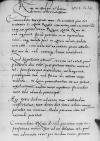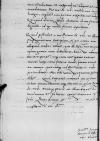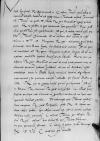De Provincial Diet of Royal Prussia ⌊comitiisProvincial Diet of Royal Prussia ⌋ quae sit sententia
s(acrae) or s(erenissimae)⌈s(acrae)s(acrae) or s(erenissimae)⌉
Sigismund I Jagiellon (Zygmunt I) (*1467 – †1548), King of Poland and Grand Duke of Lithuania (1506-1548); Duke of Głogów (Glogau) (1499-1506), Duke of Opava (1501-1506), Governor of Silesia (1504-1506); son of King Kazimierz IV Jagiellon and Elisabeth of Austria⌊maiestatis regiaeSigismund I Jagiellon (Zygmunt I) (*1467 – †1548), King of Poland and Grand Duke of Lithuania (1506-1548); Duke of Głogów (Glogau) (1499-1506), Duke of Opava (1501-1506), Governor of Silesia (1504-1506); son of King Kazimierz IV Jagiellon and Elisabeth of Austria⌋, iam antea cum ex meis litteris, tum ex ipsius etiam regiae maiestatis Reverendissima Dominatio Vestra cognovit. Facile patitur ea in Septembrem reici neque moleste fert in Maio mense habita non esse,cum iusta sit excusatio, quam attulit Reverendissima Dominatio Vestra ceterique domini consiliarii.
Quod dignitates attinet, verum est istud, quod proverbio dici solet, post festum venire miserum est. Iam fuerunt distributae me languente, priusquam litterae Vestrae Reverendissimae Dominationis essent mihi redditae. De lacu, quemadmodum se res habeat, nihil attinet eadem toties repetere, prioribus meis litteris abunde perscripsi. Ego hisce diebus adversa sum valetudine conflictatus, totos decem dies intra aedium mearum parietes me continui. Hodie primum data est exeundi potestas.
Commendatio Reverendissimae Dominationis Vestrae quantum mihi sit profutura, nescio. Hoc ad me delatum est, quod cum admonita esset per scribam suum, hominem  BCz, 1597, p. 710 mei studiosum, ut responderet aliquid ad commendationem Reverendissimae Dominationis Vestrae, vultu non satis benigno, negavit eam partem responsionis indigere hidden by binding⌈[re]re hidden by binding⌉. Quicquid Divina Maiestas statuere de me fuerit dignata, id ego animo feram aequissimo.
BCz, 1597, p. 710 mei studiosum, ut responderet aliquid ad commendationem Reverendissimae Dominationis Vestrae, vultu non satis benigno, negavit eam partem responsionis indigere hidden by binding⌈[re]re hidden by binding⌉. Quicquid Divina Maiestas statuere de me fuerit dignata, id ego animo feram aequissimo.
Quod postulat a me Reverendissima Dominatio Vestra, ut illius propugnationem suscipiam, si qui contra eam aliquid moliri velint, quo de Sigismund I Jagiellon (Zygmunt I) (*1467 – †1548), King of Poland and Grand Duke of Lithuania (1506-1548); Duke of Głogów (Glogau) (1499-1506), Duke of Opava (1501-1506), Governor of Silesia (1504-1506); son of King Kazimierz IV Jagiellon and Elisabeth of Austria
Bona Sforza (*1494 – †1557), Queen of Poland and Grand Duchess of Lithuania (1518-1557); the second wife of Sigismund I Jagiellon; Duchess of Bari and Rossano; daughter of Gian Galeazzo Sforza of Milan and Isabella of Aragon⌊serenissimorum prin hidden by binding⌈[n]n hidden by binding⌉cipumSigismund I Jagiellon (Zygmunt I) (*1467 – †1548), King of Poland and Grand Duke of Lithuania (1506-1548); Duke of Głogów (Glogau) (1499-1506), Duke of Opava (1501-1506), Governor of Silesia (1504-1506); son of King Kazimierz IV Jagiellon and Elisabeth of Austria
Bona Sforza (*1494 – †1557), Queen of Poland and Grand Duchess of Lithuania (1518-1557); the second wife of Sigismund I Jagiellon; Duchess of Bari and Rossano; daughter of Gian Galeazzo Sforza of Milan and Isabella of Aragon⌋ gratia eam deturbent, eius rei admonere hidden by binding⌈[e]e hidden by binding⌉ me non oportet. Neque enim meae ipsius rationes maiori mihi curae futurae sunt, quam erunt ea omnia, quaecumque ad Reverendissimam Dominationem Vestram pertinebunt. Hoc sibi certo persuasum habere debet.
Quod superest, commendo me et servitutem meam iterum atque iterum in gratiam Reverendissimae Dominationis Vestrae Deumque precor, ut illam servet diu incolumem et felicem.
Enclosure:
 BCz, 1597, p. 711
BCz, 1597, p. 711
Nova haec sunt. Rediit Tomasz Sobocki (*ca. 1508 – †1547), 1539-1546 Polish King's Cup-Bearer1545 deputy cup-bearer of the court, 1545 Grand Chancellor of the Crown, 1545-1546 Burgrave of Cracow, 1535 royal envoy to John Zápolya to invite him to the wedding between Princess Jadwiga Jagiellon and Joachim, Margrave of Brandenburg, 1537 royal envoy to Duke Albrecht von Hohenzollern and to Rome, 1539/1540 - to Suleiman the Magnificent (PSB 39/4, p. 557-560)⌊nuntiusTomasz Sobocki (*ca. 1508 – †1547), 1539-1546 Polish King's Cup-Bearer1545 deputy cup-bearer of the court, 1545 Grand Chancellor of the Crown, 1545-1546 Burgrave of Cracow, 1535 royal envoy to John Zápolya to invite him to the wedding between Princess Jadwiga Jagiellon and Joachim, Margrave of Brandenburg, 1537 royal envoy to Duke Albrecht von Hohenzollern and to Rome, 1539/1540 - to Suleiman the Magnificent (PSB 39/4, p. 557-560)⌋ a Suleiman the Magnificent (*1494 – †1566), 1520-1566 Sultan of the Ottoman Empire⌊caesare TurcarumSuleiman the Magnificent (*1494 – †1566), 1520-1566 Sultan of the Ottoman Empire⌋, pacem nobis et amicitiam attulit tantam, ut ad ipsos etiam The Tatars ⌊TartarosThe Tatars ⌋ miserit tyrannus ille Turcarum, ne quid
s(acrae) or s(erenissimae)()⌈s(acrae)s(acrae) or s(erenissimae)()⌉
Sigismund I Jagiellon (Zygmunt I) (*1467 – †1548), King of Poland and Grand Duke of Lithuania (1506-1548); Duke of Głogów (Glogau) (1499-1506), Duke of Opava (1501-1506), Governor of Silesia (1504-1506); son of King Kazimierz IV Jagiellon and Elisabeth of Austria⌊maiestatis regiaeSigismund I Jagiellon (Zygmunt I) (*1467 – †1548), King of Poland and Grand Duke of Lithuania (1506-1548); Duke of Głogów (Glogau) (1499-1506), Duke of Opava (1501-1506), Governor of Silesia (1504-1506); son of King Kazimierz IV Jagiellon and Elisabeth of Austria⌋ dicionibus negotii exhiberent. Qui quidem et ipse venturus huc exspectatur. Brevi, quid ab eo perfectum sit, cognoscemus. Sed qui se nobis amicum esse profitetur Suleiman the Magnificent (*1494 – †1566), 1520-1566 Sultan of the Ottoman Empire⌊Turcarum tyrannusSuleiman the Magnificent (*1494 – †1566), 1520-1566 Sultan of the Ottoman Empire⌋, is non obscure fert animo superinscribed in place of crossed-out vicino⌈vicinoanimoanimo superinscribed in place of crossed-out vicino⌉ se esse alieno a serenissimo domino John Zápolya (János Szapolyai) (*1487 – †1540), 1526-1540 King of Hungary; son of István Szapolyai and Jadwiga of Cieszyn in 1540 married Isabella, dauther of of King Sigismund Jagiellon of Poland. He fought against Ferdinand of Habsburg for the right to the title of King of Hungary⌊Hungariae regeJohn Zápolya (János Szapolyai) (*1487 – †1540), 1526-1540 King of Hungary; son of István Szapolyai and Jadwiga of Cieszyn in 1540 married Isabella, dauther of of King Sigismund Jagiellon of Poland. He fought against Ferdinand of Habsburg for the right to the title of King of Hungary⌋, alieniore procul dubio futurus, cum de nece legati sui factus erit certior. Is enim paucis comitatus ad John Zápolya (János Szapolyai) (*1487 – †1540), 1526-1540 King of Hungary; son of István Szapolyai and Jadwiga of Cieszyn in 1540 married Isabella, dauther of of King Sigismund Jagiellon of Poland. He fought against Ferdinand of Habsburg for the right to the title of King of Hungary⌊regem HungariaeJohn Zápolya (János Szapolyai) (*1487 – †1540), 1526-1540 King of Hungary; son of István Szapolyai and Jadwiga of Cieszyn in 1540 married Isabella, dauther of of King Sigismund Jagiellon of Poland. He fought against Ferdinand of Habsburg for the right to the title of King of Hungary⌋ missus, benigne ab eo acceptus, perfecta legatione dimissus est liberaliter. Qui vero ex cohorte regia adiunctus ei erat, ut curam eius gereret, neve rei alicuius penuriam pateretur, provideret, is cum eum discedentem esset comitatus, tertio a Buda (Ofen), city in Hungary, on the right bank of the Danube river, which divides Buda from Pest, capital of the Kingdom of Hungary; in 1873 Buda, Pest and Óbuda were unified to become Budapest⌊BudaBuda (Ofen), city in Hungary, on the right bank of the Danube river, which divides Buda from Pest, capital of the Kingdom of Hungary; in 1873 Buda, Pest and Óbuda were unified to become Budapest⌋ lapide interfecit hominem atque aliquot eius comites spe pecuniae cuiusdam potiundae, quae fuerat Budae relicta. Rex re cognita misit, qui eum persequerentur, sed cum in dicionem Ferdinand I of Habsburg (*1503 – †1564), from 1521 Archduke of Austria, from 1526 King of Bohemia and Hungary, Croatia and Slavonia as Ferdinand I, 1531-1558 King of the Romans, 1558-1564 Holy Roman Emperor; son of Philip I the Handsome and Joanna the Mad of Castile, a younger brother of Charles V of Habsburg⌊Romanorum regisFerdinand I of Habsburg (*1503 – †1564), from 1521 Archduke of Austria, from 1526 King of Bohemia and Hungary, Croatia and Slavonia as Ferdinand I, 1531-1558 King of the Romans, 1558-1564 Holy Roman Emperor; son of Philip I the Handsome and Joanna the Mad of Castile, a younger brother of Charles V of Habsburg⌋ aufugisset, loci illius prae superinscribed in place of crossed-out per⌈perpraeprae superinscribed in place of crossed-out per⌉fectus persequi eos ulterius non permisit. Verendum est, ne haec res ingentes turbas excitet.
De intercepto per The Ottoman Turks (Turcae) ⌊TurcasThe Ottoman Turks (Turcae) ⌋ nobilissimo emporio regis Portugaliae puto Reverendissimam Dominationem Vestram certiora istic habere. Hic adhuc rumor est, sed non omnino certus, deletum esse exercitum Suleiman the Magnificent (*1494 – †1566), 1520-1566 Sultan of the Ottoman Empire⌊caesaris TurciciSuleiman the Magnificent (*1494 – †1566), 1520-1566 Sultan of the Ottoman Empire⌋ per Ismail I Safavid (Sophi) (*1487 – †1524), 1501-1524 Shah of Persia⌊SophiIsmail I Safavid (Sophi) (*1487 – †1524), 1501-1524 Shah of Persia⌋, Persarum rege. Celantur haec fortasse per The Ottoman Turks (Turcae) ⌊TurcasThe Ottoman Turks (Turcae) ⌋ diligenter, ne qua permanent ad nos.
Cetera si potero, scribam deinceps Reverendissimae Dominationi Vestrae. Cuius me gratiae commendo.
 BCz, 1597, p. 710 mei studiosum, ut responderet aliquid ad commendationem Reverendissimae Dominationis Vestrae, vultu non satis benigno, negavit eam partem responsionis indigere hidden by binding⌈[re]re hidden by binding⌉. Quicquid Divina Maiestas statuere de me fuerit dignata, id ego animo feram aequissimo.
BCz, 1597, p. 710 mei studiosum, ut responderet aliquid ad commendationem Reverendissimae Dominationis Vestrae, vultu non satis benigno, negavit eam partem responsionis indigere hidden by binding⌈[re]re hidden by binding⌉. Quicquid Divina Maiestas statuere de me fuerit dignata, id ego animo feram aequissimo.


